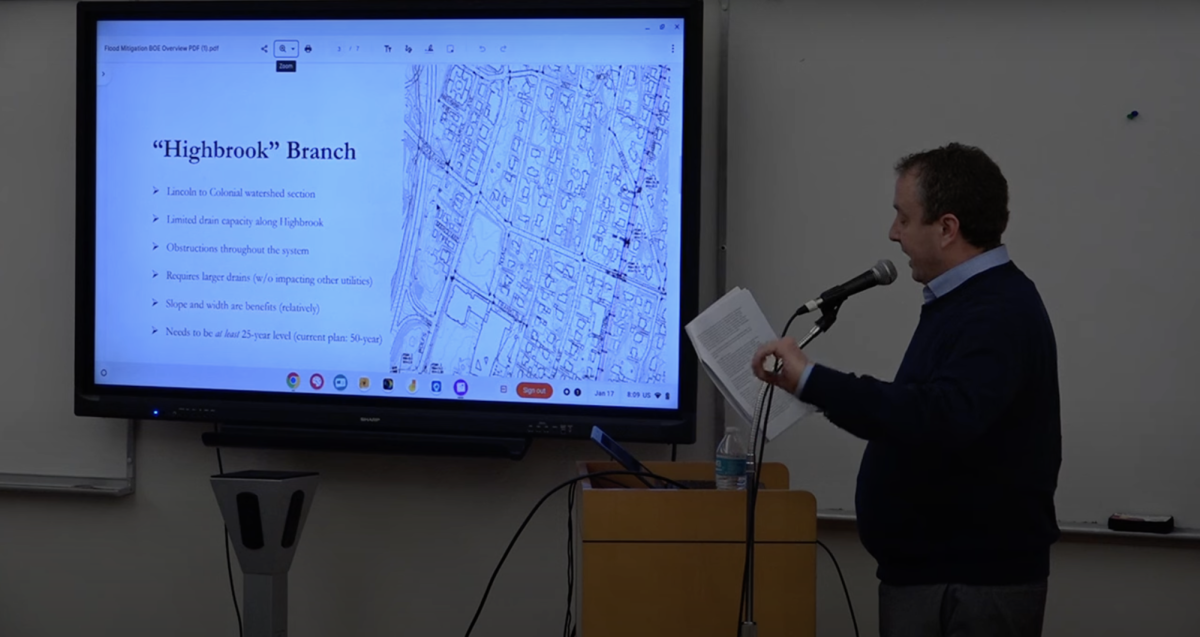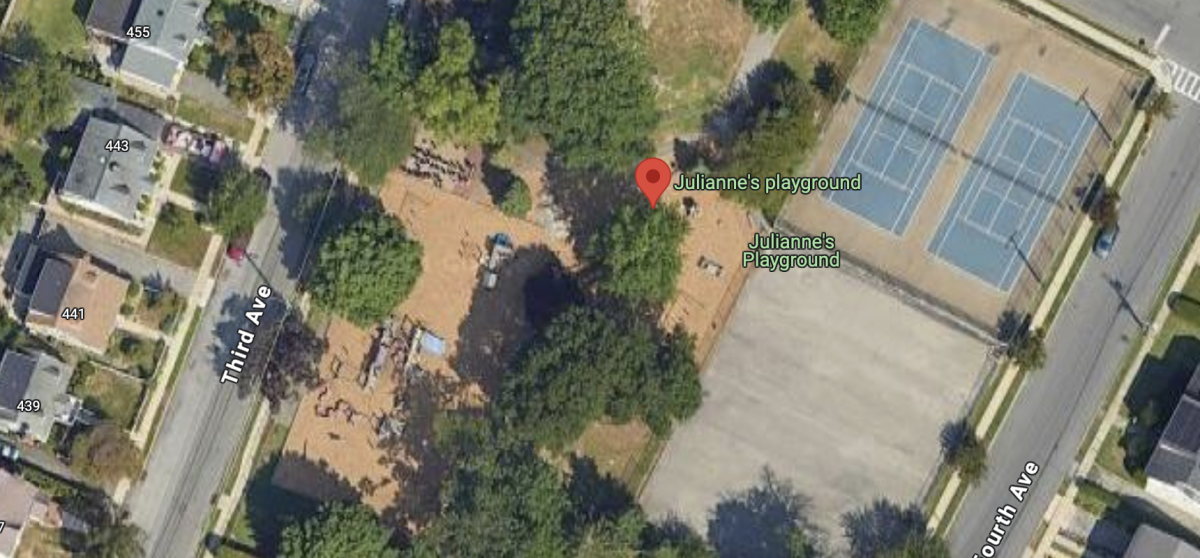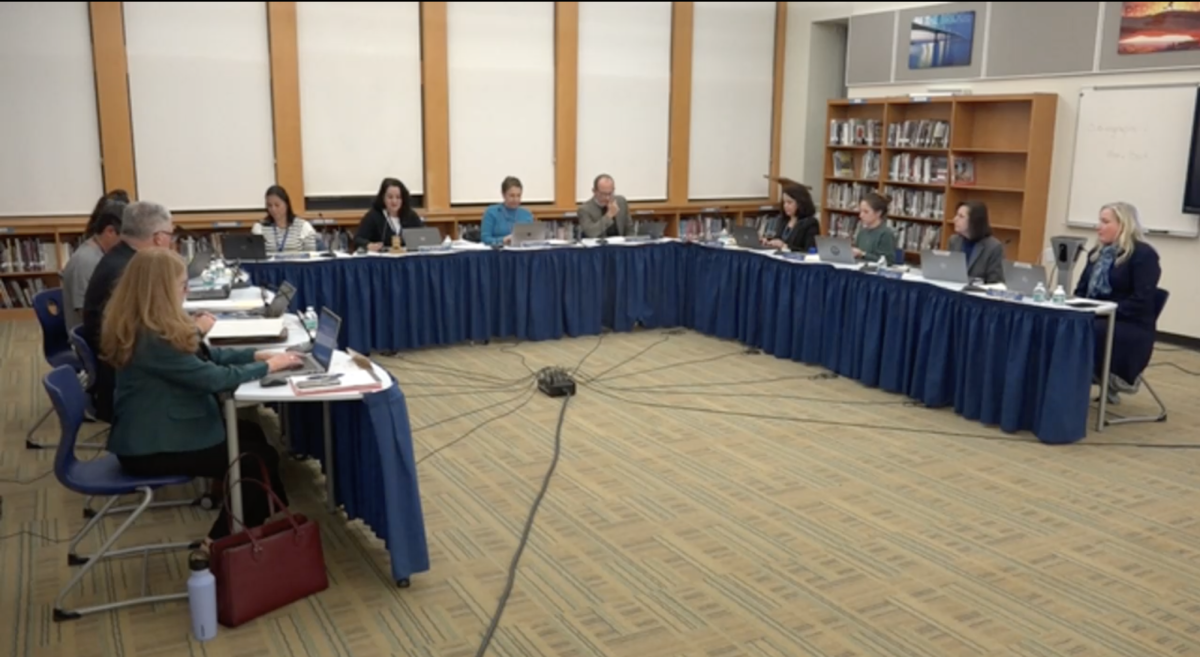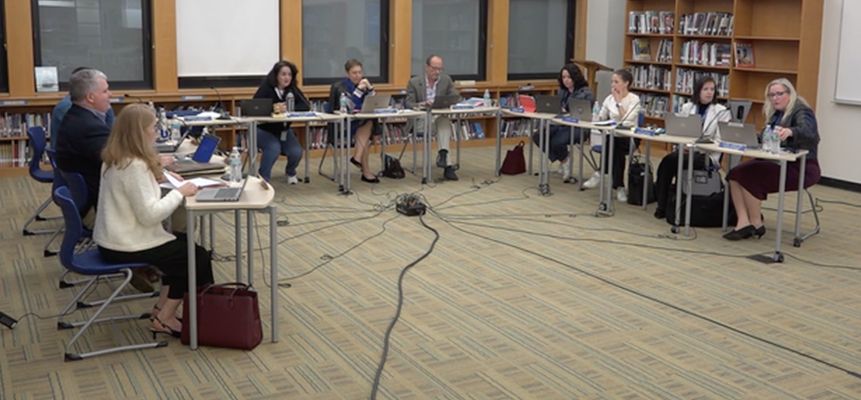Village of Pelham Mayor Chance Mullen faced skepticism Wednesday from some school trustees after presenting the village’s proposed deal for the use of district-owned Julianne’s Playground for reservoirs and pumps as part of a $39 million overhaul of the municipality’s storm sewers.
Mullen reviewed the entire sewer project during the board of education meeting, describing how it is designed to improve drainage in north Pelham and on and around Highbrook Avenue to reduce flooding during rain storms. A key component of the project is the storage system that would be built under the blacktop and tennis courts at Julianne’s Playground along with aboveground diesel pumps. In October, the village asked the school board for an easement to do that work.
“I’m not sure where each of you stands on this,” Mullen told the school board members near the end of his presentation. “I know its a lot to take in. I know that none of you asked for this, and for what it’s worth, I’d give anything in the world to not be here right now. But you are a public body that owns land in the Village of Pelham, and here we are. Cooperation is not an abdication of our fiduciary responsibility. It’s the fulfillment of it because we serve the same people. If you have ideas, the village board will consider any option (going) forward, as long as it’s fair and reasonable. But I also want to be clear that what would not be fair and reasonable is treating the health and safety of village residents as a bargaining chip or treating this entire issue like it’s the village’s problem and the school district will be just fine if we don’t address it.”
Mullen said the easement would be “an understanding of who is responsible for what.”
But Board President Dr. Owen-Michaane said, “The recommendation from our facilities committee was to not enter into an easement agreement, and that the easement agreement was not in the best interest of the school district.”
Neither Owen-Michaane nor anyone else from the school district stated at the meeting whether some other approach, such as the sale of the park to the village, would be an option so construction of the tanks can move forward. The mayor has said the village cannot start grant applications for the sewer-system revitalization until it has a deal with the school district.
At one point, Owen-Michaane seemed to become impatient with the length of Mullen’s talk.
After describing the proposed reservoir, Mullen stopped his presentation and asked the board, “Are you planning to build something on the site?”
Owen-Michaane said, “We’ll listen to your presentation, but we are not here to answer questions right now.” Soon after, he interrupted Mullen, saying, “Are you finished? We are at 25 minutes. Are you finished?”
“If you would like to reschedule this for another time we can do that,” Mullen said. “This is a health and safety matter.” He then completed his review of the plan.
Board Vice President Ian Rowe was the first to ask Mullen a question after he finished. Rowe said the land being used as a playground was originally purchased by the district for educational purposes, and that board members are “bound by that original vision. How would (the project) be consistent with that obligation?”
Mullen: “Bound by what? That’s not on the deeds.”
Rowe: “Okay, so your understanding is that we are not bound by any educational purpose?”
Mullen: “Y0u had the property for 100 years, and you haven’t built on it, so what are we bound by? In a village that’s 0.8 square miles. What are we doing? We have an opportunity to save a whole bunch of homes and families, so I guess weigh whatever that is against the benefit to our community.”
“The detention system would only be under the blacktop and tennis courts, and you won’t even know it’s there,” said Mullen during his presentation. “We have earmarked $1 million in the budget for both renovation and restoration” of the park, including $600,000 for upgrades to the playground. The project at the park would take six months to a year, he said.
Another board member asked Mullen about the possibility of the reservoir system failing.
“It’s not theoretical science, it’s something that we know works,” said Anthony Oliveri, an engineer with AI Engineers/Dolph Rotfeld Engineering Division, which developed the village’s plan. “We are designing this thing to work. It’s going to work.”
A trustee asked if one component of the project could go forward without the other, using the Highbrook Avenue conduit upgrades as an example.
“I’ve made a commitment to the community that I’m not going to fix one neighborhood and leave the historically redlined neighborhood to fend for itself,” Mullen said. “I’m not going to do that, and I think the village board is unanimous in that perspective. If we are just going to talk numbers, doing this as one big project is likely going to get a big chunk of it paid (by grants), whereas going out for grants” for a smaller portion of the project “in a higher income neighborhood is probably not going to get a lot of grant support.”
During his presentation, Mullen referred to the north Pelham area as once redlined because of the proportion of Black people that lived there. “Historically, redlined neighborhoods tend to have the worst infrastructure, and as a result have the worst flooding no matter what community you live in,” he said. “I think this project is going to be a redeeming point of pride for the community and meaningful on a lot of fronts.”
The Highbrook phase involves running a new arterial line to increase drainage capacity, according to Mullen’s presentation. “It’s the biggest pipe we could put in without hurting any utilities,” he said. “Putting in this line is essential for protecting Colonial Elementary.”
During public comment, residents were split over allowing the construction project at the playground.
“As a professional engineer doing water resources, I know these solutions are real and they work and they are implemented all the time,” said Eileen Feldman. “I want to encourage you to support this for the safety of our children, for the safety of our community and really just the betterment of the whole village and town.”
Resident and Con Edison employee Colin Leesang said, “I hear everyone talking about losing the playground. You’re not losing playground. We are asking to build something underneath the playground.” He addressed concerns that have been expressed about emissions from the diesel pumps: “You talk about diesel and particulates. Well, you can also use what they call renewable sustainable diesel, which has 90% less than regular diesel. Combine that with particulate filters, and it’s like a UPS truck sitting in front of your house.”
An audience member shouted at Leesang about the size of the pumps that would be installed at the playground. Leesang said, “The pumps are very small. You hardly see them. The pump is not bigger than a house. You are misinformed.”
Sandy Fiore, who lives across the street from the playground, spoke in opposition to the village’s proposal. “It’s an area that’s sacred to the children.”
“It’s utterly insane that that’s even an option,” said Peter Camardella of the proposal.
Scott Bardoff said, “I think you guys need to go back to the drawing board.”
During the meeting, Valerie Miller who was sworn in as district clerk to replace Pauline Davies who stepped own.
The next board of education meeting will take place Jan. 30 at 7:30 p.m. in the middle school library.








Shaun Breidbart • Jan 24, 2024 at 3:25 pm
I understand the board of ed’s reluctance to give up some land and have diesel generators there, even if they run only a few days a year. But since nobody else has proposed a different solution, I see these options:
1. Village pays the school board for lost playground time and space.
2. Village declares eminent domain, which means both parties waste money on attorneys only to end up at the same outcome as above.
3. Village buys an adjacent house and uses that space for the generators, but still needs to use the land under the playground.